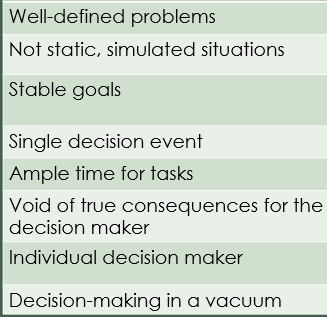FPSYC3400: Decision-Making & Critical Incident Management
1/25
Earn XP
Description and Tags
Lecture 10
Name | Mastery | Learn | Test | Matching | Spaced |
|---|
No study sessions yet.
26 Terms
Slide 4
Done
Critical Incident Management (CIM) Cycle
preparing for critical incidents
managing critical incidents
restoring public confidence
Traditional Decision Making (TDM) is related to which theory?
Classical Decision Theory
According to the Classical Decision Theory what characteristic do decision makers have?
• Are objective
• Have complete information
• Consider all possible alternatives & their consequences
• Select the optimal solution
Traditional Decision Making (TDM) Criticisms
rarely possible to consider all alternatives
impractical to consider all consequences
estimation process costs time & effort
information is rarely complete and/or accurate
individual lack mental capacity to process all the information
What is Naturalistic Decision Making (NDM) concerned with?
with how individuals and teams use their experience to assess, make meaningful decisions and take action in dynamic, uncertain, and time-pressured situations
With regard to Naturalistic Decision Making (NDM) blank is an important variable to consider
experience
Features of Naturalistic Decision Making (NDM)
• Ill-defined goals & ill-structured task
• Uncertainty, ambiguity, & missing data
• Shifting & competing gals
• Dynamic & continually changing conditions
• Action-feedback loops (real-time reactions to changed conditions)
• Time stress
• High stakes
• Multiple players
• Organizational goals & norms
• Experienced decision-makers
Essential Characteristics of Naturalistic Decision Making (NDM)
proficient decision0makers
process orientation
situation-action matching decisions rules
context-bound informal modelling
empirical-based prescription
Naturalistic Decision Making (NDM) - Field Studies
provide insight into the demand of the environment on decision-making, the affordances and constraints of those environments
Naturalistic Decision Making (NDM) - Simulations
elicit similar behaviour
realistic feautures can be built in (i.e., temporal parameters, distractions, workload)
subjects’ behaviour can be analyzed as a function of relevant factors (i.e., levels of experience)
Example: Minerva, Hydra, 10Kv
Naturalistic Decision Making (NDM) - Laboratory Techniques
can be used to help further the understanding of decision-making after a level of understanding already exists in a particular domain
Hydra is blank based training?
simulation
Hydra: Simulation-Based Training enables?
the monitoring of group dynamics, real-time leadership, and naturalistic decision-making in critical incidents
Hydra: Simulation-Based Training - Benefits
• Scenarios are immersive & often replicate real-life conditions
• Allow the person to gain experience in a safe learning environment
• Participants get experience working as a team in high-pressure environments
• Allows for formative assessments of knowledge and decision-making skills of participants

Which decision-making is related to these features?
Traditional

Which decision-making is related to these features?
Naturalistic
Which decision making cannot use all the information that is available all of the time?
Heuristics & Decision-Making
Heuristics & Decision-Making can lead to blank in decision making
biases
When is Recognition-Primed Decision-Making (RPD) model used?
complex and uncertain situations
Recognition-Primed Decision-Making (RPD) 2 processes
situation assessment
evaluation using mental simulation
Slide 16
Done
Key Features of Recognition-Primed Decision-Making (RPD)
Blend of intuition (pattern recognition) and analysis (mental simulation)
• NOT just intuition
First option is usually workable
•NOT random generation
Satisficing
•NOT optimizing
Evaluation through mental simulation
•NOT Rational Choice
Focus on elaborating and improving options
•NOT choosing between options
Focus on situation awareness
•NOT courses of action
Decision maker primed to act
NOT waiting to complete the analysis
What example in lecture is used?
“A hungry donkey stands between two identical hay piles. The donkey always chooses whichever hay is closest to him. Both piles are exactly the same distance apart, one on his right, one on his left, and they are identical in every way. Which pile of hay will the donkey choose to eat?”
Why is Critical Incident & Decision-Making research important?
There is a need to incorporate some form of judgement/decision-making theory into existing training curriculums
Knowing where uncertainty comes from allows more focused advice and recommendations to improve training
• Without prior knowledge, training, or frequent exposure, the response is generally one of stress, confusion, frustration, and fear
Result à mistakes!